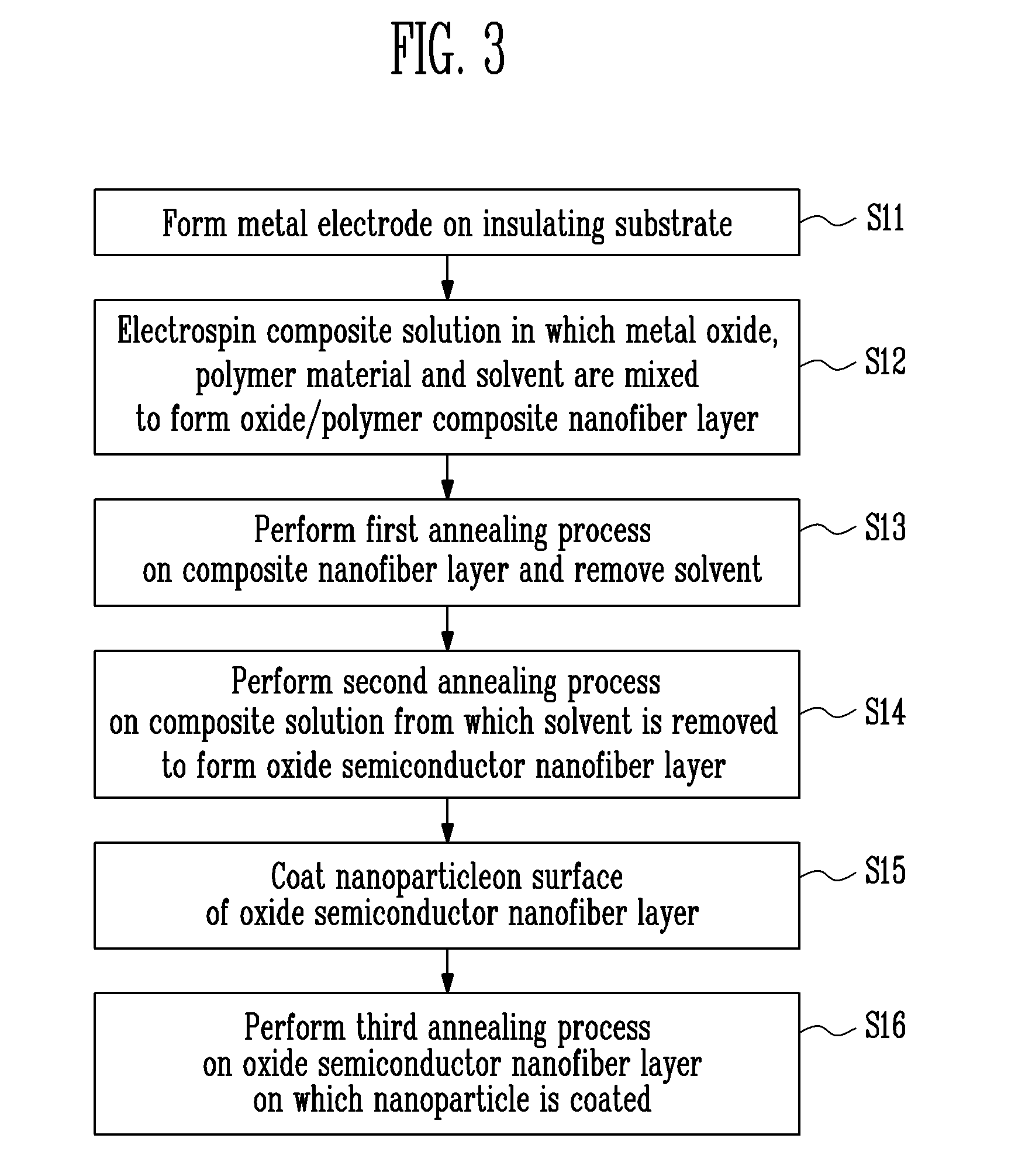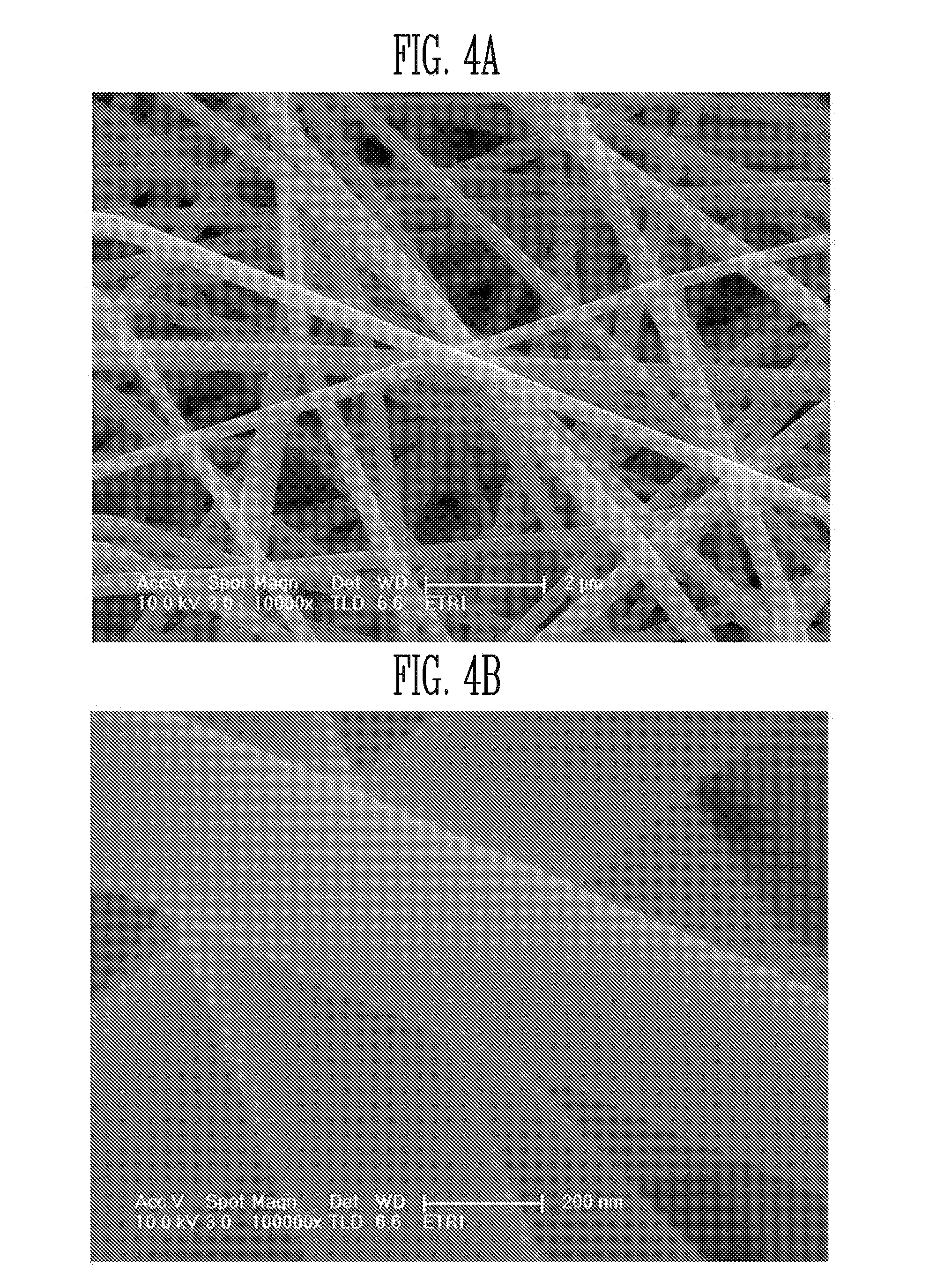Ultra-sensitive gas sensor using oxide semiconductor nanofiber and method of fabricating the same
a gas sensor and nanofiber technology, applied in the direction of instruments, electrochemical variables, coatings, etc., can solve the problems of not being able to respond/recover the same rate to a reactive gas, new process needs to be introduced, and the semiconductor oxide materials used to achieve the nanofiber-based gas sensor exhibiting high sensitivity are limited to tiosub>2 /sub>,
- Summary
- Abstract
- Description
- Claims
- Application Information
AI Technical Summary
Benefits of technology
Problems solved by technology
Method used
Image
Examples
example 1
[0072]Fabrication of a Semiconductor Oxide (ZnO) Nanofibers Layer for a Gas Sensor for Sensing Environmentally Harmful Gases
[0073]A metal oxide (ZnO) precursor, a poly(4-vinylphenol) (PVP) polymer and ethanol were weighed and mixed at a weight ratio of 5:3:1, and the mixed results were stirred at a temperature of 70□ for 10 hours to prepare a ZnO / PVP composite solution having a viscosity of 1200 cps. Then, the ZnO / PVP polymer composite solution was spun through an electrospinning device to fabricate ZnO / PVP polymer composite nanofibers on a SiO2 / Si substrate. Afterwards, a first annealing process was performed on the ZnO / PVP polymer composite nanofibers in the air at a temperature of 300□ for 30 minutes to volatilize ethanol. Subsequently, a second annealing process was performed on the ZnO / PVP polymer composite nanofibers at a temperature of 600□ for 30 minutes to obtain a semiconductor oxide (ZnO) nanofiber layer.
[0074]Characteristics of the ZnO / PVP polymer composite nanofibers an...
example 2
[0082]Fabrication of a Semiconductor Oxide (ZnO) Nanofiber Layer on which Nanoparticles for a Gas Sensor for Sensing Environmentally Harmful Gases are Coated
[0083]Using SnO2 material, which is a gas sensor material having excellent gas response characteristics, a SnO2 thin film was coated on a surface of the semiconductor oxide (ZnO) nanofibers obtained in Example 1 to a thickness of 20 nm at room temperature using a pulsed laser deposition method. Then, in order to crystallize the SnO2 nano thin film coated on the surface of the semiconductor oxide (ZnO) nanofibers, an annealing process was performed at a temperature of 600□ for 10 minutes.
[0084]The semiconductor oxide (ZnO) nanofibers layer on which SnO2 nanoparticles obtained in Example 2 were coated in a thin film form was evaluated to have the following characteristics.
[0085]FIG. 8 is a SEM image of a surface of the ZnO nanofibers layer on which SnO2 nanoparticles obtained in Example 2 are coated.
[0086]As can be seen from FIG. ...
example 3
[0091]Gas Sensor for Sensing Environmentally Harmful Gases
[0092]An interdigital transducer metal electrode (Pt) was formed to a thickness of 100 nm on a quartz substrate formed to a thickness of 0.5 mm. Afterwards, a semiconductor oxide (ZnO) nanofibers layer was formed on the electrode metal in the same manner as Example 1, and SnO2 nanoparticles formed to a thickness of 20 nm were coated on a surface of the semiconductor oxide (ZnO) nanofibers layer in the same manner as Example 2 to fabricate an ultra-sensitive nanofiber gas sensor for sensing environmentally harmful gases having the same structure as FIG. 1.
[0093]The gas sensor fabricated in Example 3 is evaluated to have the following gas response characteristics.
[0094]FIG. 11 is a graph illustrating a change in sensitivity to NO2 gas reactions according to operating temperature and time of the gas sensor for sensing environmentally harmful gases fabricated in Example 3. According to FIG. 11, the sensitivity was obtained by mea...
PUM
| Property | Measurement | Unit |
|---|---|---|
| temperature | aaaaa | aaaaa |
| temperature | aaaaa | aaaaa |
| operating temperature | aaaaa | aaaaa |
Abstract
Description
Claims
Application Information
 Login to View More
Login to View More - R&D
- Intellectual Property
- Life Sciences
- Materials
- Tech Scout
- Unparalleled Data Quality
- Higher Quality Content
- 60% Fewer Hallucinations
Browse by: Latest US Patents, China's latest patents, Technical Efficacy Thesaurus, Application Domain, Technology Topic, Popular Technical Reports.
© 2025 PatSnap. All rights reserved.Legal|Privacy policy|Modern Slavery Act Transparency Statement|Sitemap|About US| Contact US: help@patsnap.com



